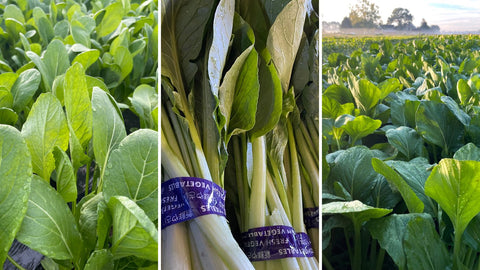Leafy Vegetables
Green SHISO (OHBA, Perilla)

Green SHISO belongs to the Perilla family and is the most well-known herb in Japan, making it an essential ingredient in Japanese cuisine. Raw SHISO leaves are commonly used as condiments to savor their unique aroma with SUSHI, and they are also used in salads, stir-fries, and deep-fried dishes. Green SHISO tempura is also incredibly delicious! In some regions, Green SHISO leaves are referred to as OHBA, which translates to "big leaf." However, the term OHBA is only used to refer to the product, not the plant or seedling.
SHISO leaves have a well-known refreshing aroma due to an essential oil composition called "perillaldehyde." In addition, SHISO leaves are believed to stimulate appetite, metabolism, and perspiration, as well as serve a preservative function. As a result, SUSHI chefs utilize Green SHISO not only for color decoration and aroma but also for its preservation qualities.
SHISO leaves have a tendency to spoil quickly, but you can extend their shelf life by wrapping them in a damp paper towel and storing them in a plastic bag. For even longer-lasting freshness, wrap each leaf individually. You may also lightly wet the SHISO leaves and store them in a plastic bag in the vegetable compartment of your refrigerator.
At Suzuki Farm, we cultivate Green SHISO year-round in our greenhouse. During the summer, we provide half shade to prevent the young leaves from hardening under strong sunlight. In contrast, during the winter, we utilize gas heaters to maintain temperatures between 70-80F, which the plants prefer. We strive to maintain a consistent supply of high-quality, hard-to-find fresh Green SHISO leaves throughout the year. Come and get your fresh Green SHISO leaves at Suzuki Farm!

Red SHISO (Perilla)

Red SHISO leaves have a unique aroma and reddish-purple color, with oval-shaped leaves featuring serrated edges. The natural hue of Red SHISO leaves is burgundy. Green SHISO leaves found in many Japanese restaurants are actually a variant of Red SHISO leaves.
The color of Red SHISO is attributed to a pigment called "anthocyanin." When mixed with acid, this pigment turns bright red, making Red SHISO leaves a popular choice for adding color to pickled plums "UMEBOSHI" and pickled ginger "BENI SHOGA." The leaves can also be salted or used for juice. To prepare, rinse the leaves thoroughly, rub them with salt, then squeeze out the excess water.
Red SHISO is a photoperiod crop, which means that it automatically develops flower buds and blooms when daylight hours become shorter. The bloomed stem "HANAHO" and stems with immature seeds "HOJISO" are both edible and add pomposity and splendor to any dish, with their good aroma. Many top chefs use them for banquets and delicacies.
At Suzuki Farm, we grow Red SHISO from June to September because they prefer high temperatures. Mr. Suzuki recommends drinking SHISO juice in the summer to prevent heat fatigue. Here are some tips to make the perfect SHISO juice: 1) Use half Green SHISO and half Red SHISO to achieve a perfect balance of color and aroma, and 2) After adding your favorite sweetener, don't forget to sprinkle a little sea salt and plenty of lemon juice to enhance the flavor and deliciousness. Keep it refrigerated and serve cold!

MITSUBA (Japanese Parsley)

MITSUBA is a member of the same family as parsley in the States and its leaves are used as an herb in Japan. The name MITSUBA comes from the way the leaves are divided into three parts, as "MITSU" means "three" and "Ba" means "leaves" in Japanese. Add MITSUBA to your MISO soup or clear soup to instantly add a vibrant color! It is a must-have herb to take your home cooking to the next level. Many think MITSUBA leaves represent a spring aroma. It is an indispensable herb in Japanese cuisine.
MITSUBA is a perennial plant. It grows 12” to 20” tall, and the leaves are oval and tapered to a point. The compound leaves are alternate and consist of three leaflets. The leaf margins have serrated double serrations. The flowering season is summer, and the flower stalks stretch out to bloom small white flowers consisting of 5 petals. After flowering, it bears oval fruit.
At Suzuki Farm, MITSUBA is a seasonal crop in spring, it is cultivated all year round due to higher demand in winter. Therefore, we sow more seeds in early autumn and grow them in greenhouses so that they can be shipped from the end of the year to March. We harvest them without cutting the roots, bundled, and delivered to everyone.

NIRA Garlic Chives

NIRA, also known as Garlic chives, are a popular vegetable in East Asia and have been consumed in Japan for a long time. The season for NIRA is from spring to early summer. These chives are rich in vitamins and minerals which help prevent swelling, improve bowel movements, and aid in the metabolism of carbohydrates and iron. They also have a distinct aroma similar to garlic due to the presence of "allicin", a compound found in NIRA. Allicin is known to relieve fatigue and suppress the rise in blood sugar levels. It is better absorbed when combined with vitamin B1, found in pork and grains. This is why many recommend pairing NIRA with pork dishes.
There are many delicious ways to enjoy NIRA, such as in stir-fries, GYOZA dumplings, soups, egg dishes, and rice porridge. To fully savor the sweetness and umami of NIRA, it's best to heat it with minimal cutting and not to overcook it as it can lose its color and flavor.
To grow NIRA, it's best to choose a sunny and well-drained location for seeding or transplanting. After sowing the seeds, they should be watered frequently. After germination, thin out the plants to widen the space between them. NIRA is strong and has a robust vitality, with new leaves growing even if the plant is cut. As a result, it can be harvested several times a year.
At Suzuki Farm, we only grow and harvest the green leaves of NIRA. Please enjoy this highly nutritious and heat-tolerant plant, one of the few vegetables we can harvest in the middle of summer!

MOROHEIYA (Mulukhiya)

If you're looking for a nutritious vegetable, consider trying MOROHEIYA. Originally from Africa, the Middle East, and India, it has deep green leaves and is also known as Jew's Mallow or Egyptian spinach. Although it resembles SHISO leaves, it is not a member of the perilla family. This leafy vegetable is packed with vitamins and minerals, making it a popular ingredient in dietary supplements. Due to its high nutritional value, MOROHEIYA is also known as the "King of Green Vegetables" or the "Mighty Vegetable."
Raw MOROHEIYA has a bitter taste, but take care not to overcook it as it will lose its nutrients. Cooking with oil can increase your intake of vitamins A, E, and K. We highly recommend MOROHEIYA tempura or stir-fry! When cutting the leaves, they become sticky. If you enjoy NATTO fermented beans, they go well with chopped MOROHEIYA leaves.
Gardening MOROHEIYA is relatively easy in the summer as the plants grow well in temperatures ranging from 70 to 90F. Just be sure to water them well when the soil becomes dry. MOROHEIYA is a short-day plant, meaning it begins to flower in late summer. When growing MOROHEIYA at home, DO NOT eat any of the seeds as they contain a toxic substance that affects the heart. On the other hand, the MOROHEIYA leaves sold in stores and online are safe to consume.
At Suzuki Farm, we grow MOROHEIYA from June to August. Although it has only become popular in Japan since the 1990s, we believe that it is one of the best vegetables to eat in the summer due to its high nutritional value. Its unique sticky texture may be unusual for some, but we still recommend giving it a try to our health-conscious customers.

KOMATSUNA Leaves

KOMATSUNA, a versatile leafy vegetable hailing from the Brassicaceae family, is a culinary gem often overlooked in salads but suitable for a myriad of cooking methods such as stir-frying and steaming. Its mild flavor makes it universally appealing, enjoyed by individuals of all ages and genders. Beyond its taste, KOMATSUNA boasts a rich nutritional profile, abundant in vitamins, calcium, iron, and folic acid.
Originating from the banks of a river east of Tokyo, KOMATSUNA has garnered widespread acclaim as an exceptional vegetable, with cultivation expanding across Japan in recent years. Notably, its moderate heat resistance ensures year-round availability, including during the summer months.
At Suzuki Farm, we prioritize cultivating vegetables throughout the year, including the cold winter season. Leveraging greenhouse technology, we ensure a steady supply year-round. However, fluctuations in temperature and other weather conditions pose challenges, requiring careful planning and adaptation in our cultivation practices. While we strive to maintain a consistent harvest of KOMATSUNA, occasional shortages may occur due to unforeseen factors impacting our planting calculations.

MIZUNA Leaves

While MIZUNA is now a staple vegetable across Japan, it was primarily distributed in the Kansai region, particularly Kyoto, around 40 years ago. Its popularity surged when it was discovered that children relished its addition to hot pots. Over time, improved varieties and increased productivity led to a rise in MIZUNA availability. Many rave about the delectable taste of MIZUNA salad when paired with sesame dressing.
At Suzuki Farm, akin to KOMATSUNA, we cultivate MIZUNA year-round. However, its delicate leaf structure poses challenges in extreme weather conditions. Nonetheless, given MIZUNA's integral role in culinary settings, we are committed to ensuring a consistent supply to meet the demands of restaurants and customers alike.

SHUNGIKU Leaves

One of the most beloved ways to enjoy SHUNGIKU is in a comforting hot pot. However, its culinary versatility extends to "ohitashi," "gomaae,", and "tempura." Paired with soy sauce, it transforms into a delectable stir-fry with garlic and butter.
At Suzuki Farm, we nurture SHUNGIKU year-round, with a focus on winter cultivation. Despite the slower growth in cooler temperatures, our crops rebound with fresh stems and leaves after each harvest, allowing for multiple yields. However, vigilance is required during warmer spells, as flowering may occur, resulting in toughened stems unsuitable for consumption.

HORENSO Spinach

Did you know there are two main types of spinach: the European variety and the East Asian variety? The European variety, often sold as baby spinach in the United States, has round-tipped leaves. The East Asian variety, introduced to Japan before the Edo period (1603-1867), boasts a rich history of cultivation and unique varieties. While an increasing varieties of spinach types influenced by European breeds have become available in Japan, many still feature pointed leaves.
At Suzuki Farm, we exclusively cultivate HORENSO Spinach from late fall to early spring, when it's at its peak flavor. Spinach grown in hot weather tends to have thinner mesophyll and less flavor, so we focus on cultivating it during cooler seasons to ensure top-quality produce. With its dark color and thick mesophyll, our HORENSO Spinach is a seasonal delicacy worth savoring. If you have the chance to try it, we highly recommend it!

Sweet Cabbage

Cabbage stands as the most beloved vegetable in Japanese households, often securing the top spot in favorites lists. Interestingly, it doesn't seem to enjoy the same level of consumption in America. The reason, we suspect, is due to the predominant types of cabbage available in the U.S., which tend to be tougher, lending themselves better to cooking methods like stir-frying and pickling rather than being enjoyed raw. At Suzuki Farm, we break from the norm by cultivating varieties of cabbage that are notably tender and have a subtle sweetness.
Cabbage isn't just versatile in the kitchen; it's packed with nutrients. While it's commonly shredded and dressed or mixed with mayonnaise, it's also excellent in stir-fries and stews. But if you're looking for something truly special, I recommend steamed cabbage. Just layer slices of cabbage with pork in a pot, add a bit of consommé and a splash of SAKE (Japanese rice wine), and steam. Turning it once during cooking transforms these simple ingredients into a dish that is both effortless and indulgent. We encourage you to experience it.
At Suzuki Farm, our Sweet Cabbage hits its main shipping season from late May through June and then again from mid-September to December. The late autumn to winter months, in particular, allow us to cultivate exceptionally tasty crops. Our goal is to continue offering our delicious cabbage, aspiring for it to become a staple in classic American cuisine, as indispensable and cherished as it is in Japan.

